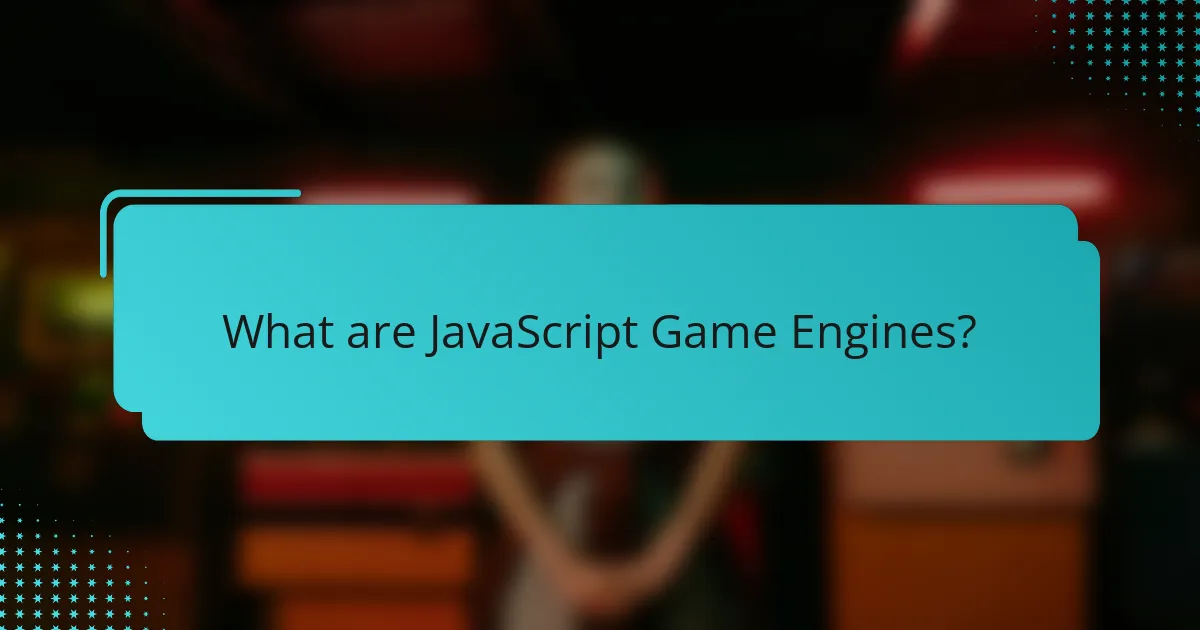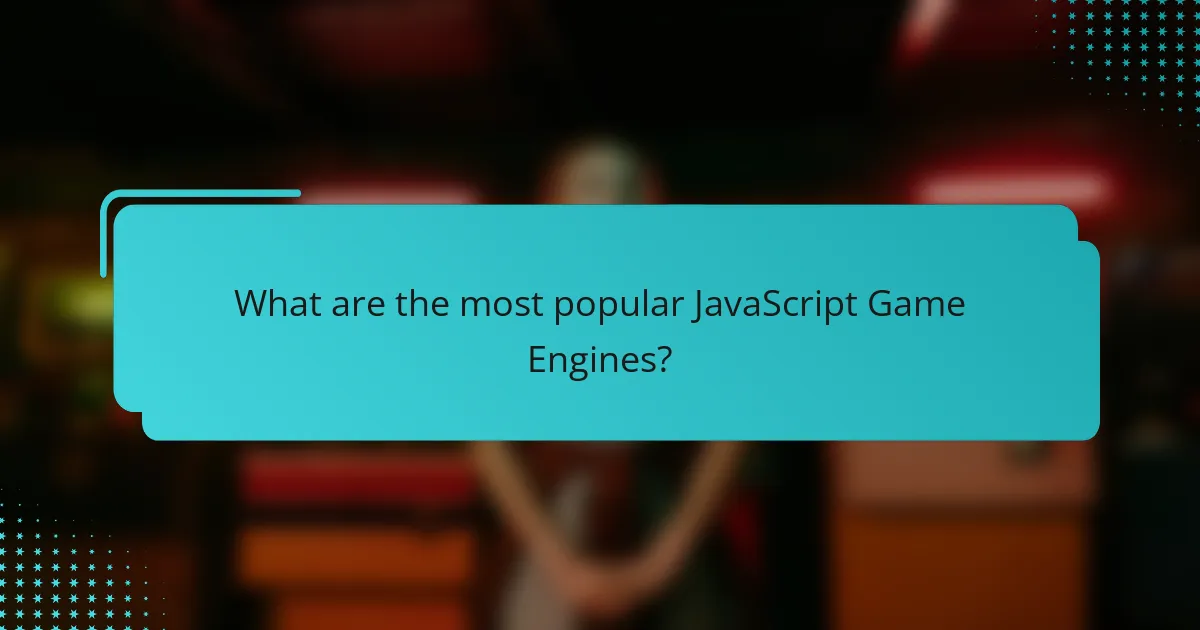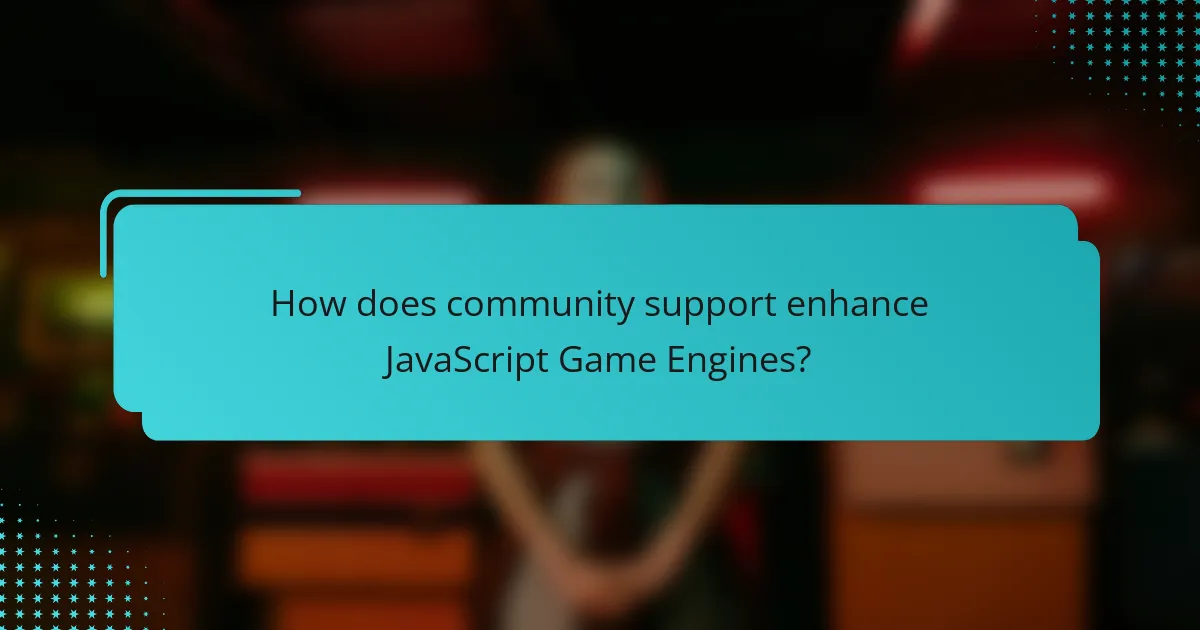
What are JavaScript Game Engines?
JavaScript game engines are software frameworks designed to facilitate the development of games using JavaScript. They provide essential tools, libraries, and functionalities to streamline game creation. These engines often include rendering engines, physics engines, and asset management systems. Popular JavaScript game engines include Phaser, Three.js, and Babylon.js. They enable developers to create both 2D and 3D games for web platforms. JavaScript game engines leverage the capabilities of web browsers, allowing games to run seamlessly across different devices. The use of these engines has grown, with a significant increase in web-based gaming. According to a report by Statista, the global gaming market is projected to reach $200 billion by 2023, highlighting the importance of accessible game development tools.
How do JavaScript Game Engines function?
JavaScript game engines function by providing a framework for developers to create games using JavaScript. They facilitate game development by offering pre-built libraries and tools. These engines handle graphics rendering, physics calculations, and user input management. They often include features like sound management and animation systems. Developers can leverage these engines to streamline the game development process. Popular examples include Phaser, Three.js, and Babylon.js. Each of these engines has its own set of functionalities tailored to different types of games. For instance, Phaser is known for 2D game development, while Three.js specializes in 3D graphics. This specialization allows developers to choose an engine that best fits their project needs.
What are the key components of JavaScript Game Engines?
The key components of JavaScript game engines include rendering, physics, input handling, and asset management. Rendering is responsible for displaying graphics on the screen. Physics engines simulate real-world physics for realistic movements and collisions. Input handling captures user interactions from devices like keyboards and mice. Asset management organizes and loads game resources like images, sounds, and scripts. Additionally, scripting support allows developers to implement game logic and behaviors. These components work together to create interactive and engaging gaming experiences.
How do these components interact to create games?
Game components interact through a structured framework that combines graphics, physics, and user input. JavaScript game engines utilize these components to render visuals and manage game logic. The rendering engine draws graphics on the screen, while the physics engine ensures realistic movement and collision detection. User input is processed to control characters or objects within the game.
For instance, when a player presses a key, the input is captured and translated into an action, such as moving a character. This action triggers updates in the game state, which the rendering engine reflects visually. The interaction between these components enables real-time gameplay experiences. Popular JavaScript frameworks like Phaser and Three.js exemplify this integration by providing built-in functionalities for graphics, physics, and input handling.
What are the advantages of using JavaScript Game Engines?
JavaScript game engines offer several advantages. They enable cross-platform development, allowing games to run on various devices with minimal changes. Their integration with web technologies simplifies deployment via browsers. JavaScript engines often have large communities, providing extensive support and resources. Many engines are open-source, reducing costs for developers. Additionally, they support rapid prototyping, facilitating quicker game development. Performance optimization features in these engines enhance gameplay experiences. Popular frameworks like Phaser and Three.js demonstrate these benefits effectively.
How do JavaScript Game Engines enhance game development efficiency?
JavaScript game engines enhance game development efficiency by providing pre-built libraries and tools. These engines streamline coding processes, allowing developers to focus on gameplay rather than low-level programming. They support rapid prototyping, enabling quick iterations and testing of game mechanics.
JavaScript engines also facilitate cross-platform compatibility, allowing games to run on various devices without extensive modifications. Additionally, they often include built-in physics engines, rendering capabilities, and sound management, which reduces the need for external resources.
Frameworks like Phaser and Three.js are examples of popular JavaScript game engines that offer extensive documentation and community support. This support leads to faster problem-solving and sharing of best practices among developers. Overall, these features significantly reduce development time and increase productivity.
What unique features do JavaScript Game Engines offer to developers?
JavaScript game engines offer unique features that enhance game development efficiency and flexibility. They provide cross-platform compatibility, allowing games to run on various devices and browsers without modification. Many engines include built-in physics engines, which simplify the implementation of realistic motion and collision detection. Additionally, they often come with robust asset management systems, enabling easy handling of graphics, sounds, and animations.
JavaScript game engines support real-time multiplayer functionality, facilitating engaging online experiences. They also feature extensive libraries and frameworks, which accelerate development by providing pre-built functions and components. Furthermore, many engines are open-source, fostering community collaboration and continuous improvement. This collaborative environment leads to a wealth of plugins and extensions, further enhancing the development process.

What are the most popular JavaScript Game Engines?
The most popular JavaScript game engines include Phaser, Three.js, Babylon.js, and PlayCanvas. Phaser is widely recognized for 2D game development and has extensive documentation. Three.js specializes in 3D graphics and is used for rendering complex scenes. Babylon.js offers a powerful framework for 3D games and supports WebXR for virtual reality. PlayCanvas is known for its collaborative development environment and cloud-based platform. These engines are favored due to their robust features and strong community support.
Which JavaScript Game Engines are widely used in the industry?
Three widely used JavaScript game engines in the industry are Unity with WebGL, Phaser, and Babylon.js. Unity supports game development across multiple platforms and utilizes WebGL for browser-based games. Phaser is known for its 2D game development capabilities and has a strong community backing. Babylon.js excels in 3D graphics and provides robust tools for creating immersive experiences. These engines are popular due to their versatility, extensive documentation, and active community support.
What are the core features of Phaser?
Phaser is a popular HTML5 game framework with several core features. It supports both 2D and 3D graphics through a robust rendering engine. Phaser includes a comprehensive suite of tools for physics, animations, and input handling. It offers a rich asset management system for images, sounds, and sprites. The framework provides an extensive plugin architecture for adding custom functionality. Phaser also has a strong community and extensive documentation for developers. It is compatible with multiple platforms, including desktop and mobile devices. The framework allows for easy integration with other libraries and tools.
How does Three.js support 3D game development?
Three.js supports 3D game development by providing a comprehensive library for rendering 3D graphics in web browsers. It simplifies complex tasks like scene creation, object manipulation, and lighting. Developers can easily create and animate 3D models with its built-in features. Three.js supports various file formats for importing 3D assets, such as OBJ and FBX. It also includes a powerful camera system for dynamic viewpoints. The library is optimized for performance, enabling real-time rendering. Additionally, Three.js has a large community and extensive documentation, which aids developers in troubleshooting and enhancing their projects.
What criteria should developers consider when choosing a JavaScript Game Engine?
Developers should consider performance, ease of use, community support, and available features when choosing a JavaScript Game Engine. Performance affects the game’s speed and responsiveness. Engines like Phaser and Three.js are known for their high performance. Ease of use relates to the learning curve for new developers. Engines with comprehensive documentation, like Babylon.js, facilitate quicker onboarding. Community support is crucial for troubleshooting and resources. A strong community can provide tutorials and forums, enhancing the development experience. Features such as 2D or 3D capabilities, physics engines, and asset management should align with the project requirements. Engines like PlayCanvas offer robust 3D features, making them suitable for complex projects.
How do performance and scalability impact engine selection?
Performance and scalability significantly influence engine selection in JavaScript game development. High performance ensures smooth gameplay and quick response times, which are crucial for user experience. Scalability allows a game to handle increased loads, such as more players or complex graphics, without performance degradation. Engines that optimize resource management and processing power are preferred for performance. Additionally, scalability features like modular architecture enable developers to expand game functionalities seamlessly. For example, engines like Unity and Phaser are known for their strong performance metrics and scalability options, making them popular choices among developers.
What role does community support play in choosing a game engine?
Community support is crucial in choosing a game engine. It provides resources like forums, tutorials, and documentation. A strong community can offer troubleshooting assistance and share best practices. This support can significantly reduce development time. Engaging with an active community fosters collaboration and innovation. Popular engines often have larger communities, leading to more plugins and assets. For example, Unity has a vast community that contributes to its extensive asset store. Community support can also influence the long-term viability of the engine. Engines with robust community backing are more likely to receive regular updates and improvements.

How does community support enhance JavaScript Game Engines?
Community support enhances JavaScript game engines by providing resources, collaboration, and feedback. Active communities contribute to open-source projects, improving engine features and performance. They create tutorials and documentation, making it easier for new developers to learn. Forums and discussion groups facilitate problem-solving and knowledge sharing. Community-driven events, like game jams, promote innovation and creativity. The collective expertise helps in identifying bugs and optimizing code. As of 2023, platforms like GitHub host numerous JavaScript game engine projects, showcasing community contributions. This collaboration leads to faster development cycles and richer features in game engines.
What resources are available for developers using JavaScript Game Engines?
Developers using JavaScript game engines have access to various resources. These include documentation, tutorials, and community forums. Popular engines like Phaser and Three.js provide extensive official documentation. Online platforms like MDN Web Docs also offer resources for JavaScript and game development. Additionally, video tutorials on YouTube can help developers learn practical skills. GitHub repositories often contain sample projects and code snippets. Community forums like Stack Overflow facilitate peer support and problem-solving. These resources collectively enhance the development experience for JavaScript game developers.
How can forums and online communities assist developers?
Forums and online communities assist developers by providing platforms for knowledge sharing and problem-solving. Developers can ask questions and receive answers from experienced peers. This interaction fosters collaboration and learning. Communities often host discussions around specific technologies or frameworks. These discussions can lead to insights and best practices. Additionally, forums allow developers to share resources like code snippets and tutorials. Engaging in these communities can enhance a developer’s skill set. Research indicates that 70% of developers rely on online forums for troubleshooting and advice. This statistic highlights the value of community support in the development process.
What role do tutorials and documentation play in community support?
Tutorials and documentation are essential components of community support for JavaScript game engines. They provide users with step-by-step guidance on how to effectively use the engines. This guidance helps reduce the learning curve for new developers. It also enables experienced developers to troubleshoot issues more efficiently. Well-structured tutorials can foster a sense of community by encouraging collaboration and sharing of knowledge. Furthermore, comprehensive documentation ensures that users have access to all necessary information, promoting best practices. According to a survey by Stack Overflow, 70% of developers rely on documentation when learning new technologies. Thus, tutorials and documentation significantly enhance community engagement and support within the JavaScript game engine ecosystem.
What are some best practices for engaging with the JavaScript Game Engine community?
Engaging with the JavaScript Game Engine community involves several best practices. First, contribute to open-source projects. This strengthens community ties and enhances skills. Second, participate in forums and discussion groups. Platforms like GitHub and Discord are popular for real-time interaction. Third, share your work and insights. This can inspire others and foster collaboration. Fourth, attend meetups and conferences. Networking in person builds relationships and knowledge. Fifth, provide constructive feedback on others’ projects. This encourages growth and improvement within the community. Lastly, stay updated with industry trends. Following blogs and social media accounts keeps you informed and relevant. These practices enhance your engagement and support the community effectively.
How can developers contribute to open-source projects?
Developers can contribute to open-source projects by submitting code, reporting bugs, and providing documentation. They can start by forking the repository and creating a new branch for their changes. After making improvements, developers can submit a pull request for review. This process encourages collaboration and enhances the project. Additionally, developers can engage in discussions on issue trackers to suggest features or improvements. They can also help by reviewing pull requests from others, which fosters a supportive community. According to the Open Source Initiative, contributing to open-source projects can enhance developers’ skills and expand their professional networks.
What strategies can developers use to network within the community?
Developers can network within the community by participating in online forums and social media groups. Engaging in discussions on platforms like GitHub, Reddit, and Discord helps build connections. Attending local meetups or conferences allows developers to meet peers face-to-face. Collaborating on open-source projects fosters relationships through shared goals. Contributing to community-driven documentation enhances visibility and credibility. Sharing knowledge via blog posts or tutorials establishes authority in the field. Joining coding challenges or hackathons promotes teamwork and networking opportunities. These strategies collectively strengthen community ties and enhance professional growth.
What tips can help developers maximize their experience with JavaScript Game Engines?
Developers can maximize their experience with JavaScript game engines by focusing on a few key strategies. First, they should choose the right engine based on project needs. Popular engines like Phaser and Three.js offer different capabilities. Second, mastering the engine’s documentation is crucial. Comprehensive documentation provides essential insights and examples. Third, leveraging community resources enhances learning. Online forums and tutorials can offer valuable support. Fourth, practicing coding regularly helps reinforce skills. Consistent practice leads to improved proficiency. Fifth, collaborating with other developers fosters knowledge sharing. Team projects can enhance problem-solving skills. Lastly, staying updated with industry trends is important. Following blogs and attending webinars can provide new insights. These strategies collectively contribute to a more enriching development experience.
JavaScript game engines are software frameworks that streamline the development of games using JavaScript, offering essential tools such as rendering, physics, and asset management systems. This article provides an overview of popular JavaScript game engines like Phaser, Three.js, and Babylon.js, detailing their functionalities, advantages, and community support. Key components and their interactions in game development are discussed, along with best practices for engaging with the developer community and maximizing the use of these engines. Resources available for developers, including tutorials and forums, are highlighted to enhance the overall development experience.